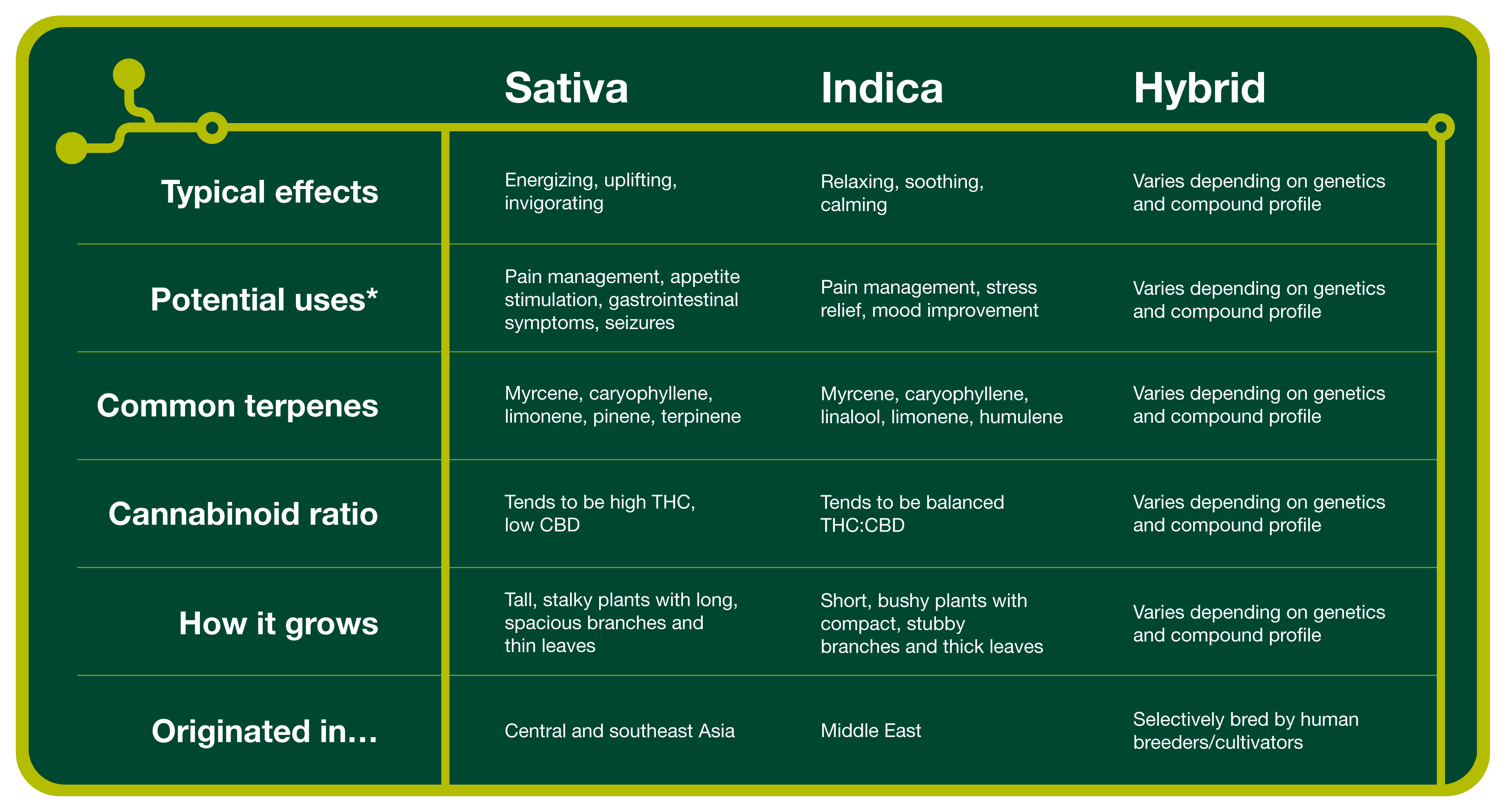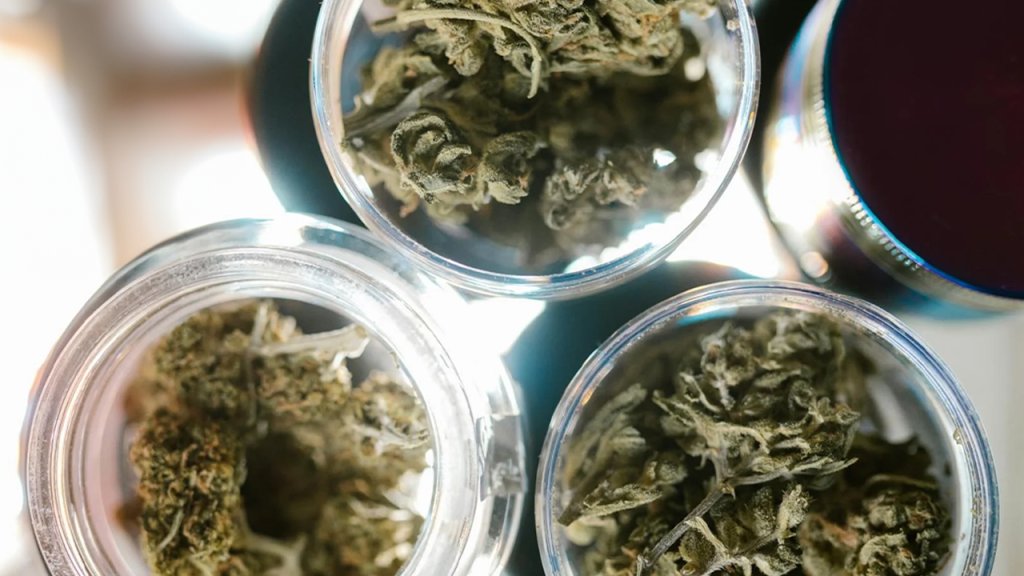Sativa, indica, hybrid — oh, my! These words get tossed around a lot in the dispensary, but what do they actually mean? More importantly, how can they help you make the right decision when you’re buying a cannabis product? Shop with confidence with this guide in hand.
Sativa vs. Indica vs. Hybrid: What’s the difference?
The terms “sativa” and “indica” refer to two separate species of cannabis plants, which are part of the Cannabaceae family. These species originated in different parts of the world and, as a result, tend to have distinct characteristics and exert different effects when consumed.
Within each species, there are distinct varieties of cannabis, known as cultivars or strains. Each strain has its own unique genetic makeup and tendencies. That means no two indica or sativa strains are identical, even though they belong to the same species.
Cultivators selectively breed sativa and indica strains to produce a third category of plants known as hybrids. These strains combine the genetics of two of more plants, further blurring the line between indica and sativa. The result is an ever-expanding list of specialized plants bred for specific characteristics or effects.

The indica, sativa, and hybrid divide is not always so simple
As you can see in the chart, indica and sativa plants tend to have some predictable differences. Sativa plants, for example, tend to result in a more energizing high, while indica are often more relaxing. These general experiences have led to common turns of phrase like “indica = in da couch.” Other “typical” aspects of each species are not always true, either. For example, the ratio of delta-9 Tetrahydrocannabinol (THC) to Cannabidiol (CBD) isn’t always predictable.
Of course, this isn’t always the case when dealing with a sativa or indica strain, and hybrid strains – which today include most of the strains you’ll come across – are even less predictable. That means the indica, sativa, and hybrid categories should be a guide and not a be-all, end-all recommendation for the kind of experience you want.
You may find a sativa strain or sativa-dominant hybrid that’s deeply relaxing and calming. On the other hand, there’s always a chance that an indica strain or indica-dominant hybrid puts some pep in your step. The strain itself, as well as your individual reaction to it, means it’s hard to rely on generalizations. Understanding specifics makes for smart shopping.
What you should consider when buying cannabis beyond indica, sativa, and hybrid
If you want to more accurately gauge how a strain of cannabis may affect you, it’s better to get specific than rely on the species of the plant alone.
Cannabinoid profile
The cannabinoid profile includes THC potency, CBD potency, and minor cannabinoids like Cannabigerol (CBG) or Cannabinol (CBN). Licensed cannabis products are required by New York State law to include the active cannabinoid concentration on the label. Every label must also include information you can use to look up the complete laboratory testing results, such as product name and form, specific unique lot number, net contents, and target potencies.
THC-to-CBD ratio
Understanding how much THC is present relative to CBD content can help you gauge how intense of a high you might feel. Generally, balanced THC-to-CBD ratios and high CBD-to-THC ratios result in a more muted cerebral feeling.
If you don’t want to feel too high or have a low tolerance, look for even THC-to-CBD ratio or CBD-dominant formulas. 5:1, 10:1, and 20:1 CBD to THC ratios are common. If you want the THC with just a bit of balance, try 2:1, 4:1, 5:1 or higher THC to CBD ratio.
If your product has more than just THC and CBG, those cannabinoids may be included in the ratio as well. For example, Camino Blackberry Dream gummies have a 1:1:1 ratio of THC, CBN, and CBD per serving, and it says so on the label.
Terpene profile
Terpenes are the compounds that give cannabis its unique aromas and flavors, and they can also influence how it makes you feel. So, they’re important for finding products that smell and taste pleasant, but that also shape the effects you’re looking for. Terpenes like limonene, for example, are known for influencing uplifting moods and providing bursts of energy. Terpenes like myrcene are commonly associated with relaxation and restful sleep.
Entourage effect
When all the different compounds in cannabis appear in different proportions to one another, they may exert different effects. This theory is called the “entourage effect.” Take this into account when choosing a cannabis product, and take note of how products with varying levels of the same compounds affect you differently.
Product type
The type of product you choose will have a big impact on your experience. For example, a strain may affect you one way when you purchase it in flower form, but if you buy concentrates or choose edibles, you may have a totally different experience.
When you find a strain of cannabis you particularly enjoy, take note of each of these factors. You can use them to choose similar strains in the future, and you’ll likely enjoy them, too. The same goes for strains you want to avoid in the future; keep tabs on the combinations of compounds and which work (and don’t work) for you.
Examples of sativa, indica, and hybrid strains
As the factors above suggest, the best way to understand how a specific strain may affect you is to take a look at it individually. Let’s apply those factors to a couple strains of each species to see how you can use them to choose the right one for you in a dispensary. To keep it simple, we’ll assume the product type for each of these strains is just regular cannabis flower.
Examples of sativa strains
- Durban Poison: Hailing from the South African city of Durban, this pure sativa is renowned for its balanced potency and invigorating, uplifting effects. Durban Poison boasts an average THC content of 19%, along with notable amounts of Cannabigerol (CBG), a minor cannabinoid that may be linked to enhancing mood and energy. An energetic buzz, enhanced creativity, and a cheerful disposition are the typical descriptions Durban Poison consumers use to discuss this strain. Durban Poison is rich in terpenes such as terpinolene, myrcene, and ocimene, contributing to its signature effects and aroma.
- Acapulco Gold: Acapulco Gold is known for its ability to lift spirits and provide a burst of energy, making it a go-to option for motivation or tackling creative projects. This moderately potent strain has an average THC content of 18% and is rich in CBG, which contributes to its energizing and mood-boosting qualities. With a terpene profile dominated by caryophyllene, myrcene, and limonene, Acapulco Gold offers both an invigorating high and a complex aroma.
- Thai: As its name suggests, Thai originates from Thailand and is cherished for its uplifting and focused high, making it a favorite for creative endeavors. With an average THC level of 19%, this moderately potent strain also contains substantial amounts of CBG, which adds to its euphoric qualities. The terpene profile commonly includes caryophyllene, limonene, myrcene, and terpinolene, giving it a unique combination of flavors and effects.
Examples of indica strains
- Hindu Kush: Hindu Kush hails from the rugged mountain ranges straddling the borders of Afghanistan and Pakistan and is known for its earthy aroma and resin-rich buds. This pure indica strain typically features THC levels ranging from 15% to 20% and showcases a terpene profile rich in myrcene, caryophyllene, and pinene. Celebrated for its dense, sticky flowers, Hindu Kush has been a cornerstone in traditional hash production. Its effects are profoundly calming, offering deep physical relaxation and mental serenity.
- Afghani: Originating from the northern regions of Afghanistan, Afghani is a classic indica strain revered for its resilience and therapeutic effects. With THC levels averaging between 17% and 22%, Afghani boasts a terpene profile dominated by myrcene and humulene, known for their relaxing and sedative properties. This strain is widely appreciated for delivering intense physical relief, muscle relaxation, and a tranquil, deeply soothing high reflective of its mountain heritage.
Examples of hybrid strains
- Blueberry: This indica-dominant hybrid was bred using the pure sativa Thai strain, demonstrating how unpredictable genetic lineage can be when dealing with hybrid strains. Blueberry is commonly associated with sleepy, relaxing vibes and waves of euphoria, likely thanks to the high levels of CBG that accompany its moderately potent THC content of 17%. Most consumers reach for Blueberry when managing pain or dealing with stress, as it’s quite effective at taking the edge off of both.
- Sour Diesel: A strain with east coast roots, this sativa-dominant hybrid offers an uplifting, energetic, and talkative high, which may seem in line with the conventional wisdom surrounding sativa strains. However, many consumers also report Sour Diesel is great for stress-busting. This moderately potent strain contains an average 19% THC content with virtually no CBD to speak of, so expect its heady, cerebral effects to hit hard and fast.
- White Widow: This balanced hybrid blends indica and sativa genetics evenly to create a euphoric, talkative, and uplifting experience. White Widow is a good example of how genetics alone are not a reliable determinate of effects, as it has one pure indica parent and one pure sativa parent. This gentle strain contains about 15% THC content, along with significant levels of CBG. It’s often reported as an effective choice for stress relief and pain management.
Find the best strain for you at The Plant
Cannabis is a complex thing, but at The Plant we’re here to help. Stop by our dispensary in Yonkers, NY to see everything we have to offer or to discuss your questions and needs with one of our budtenders. We’ll be sure you leave with good information and even better cannabis products, so pay us a visit today.


